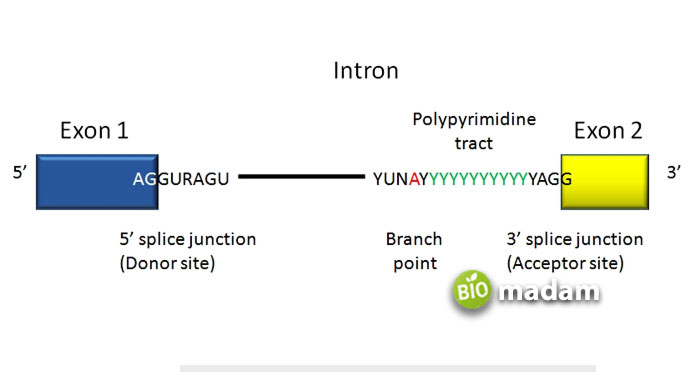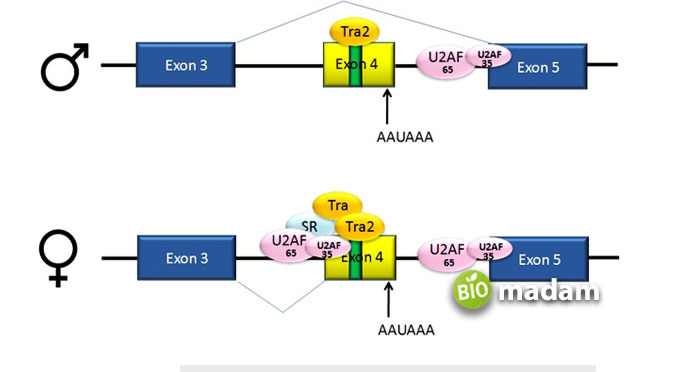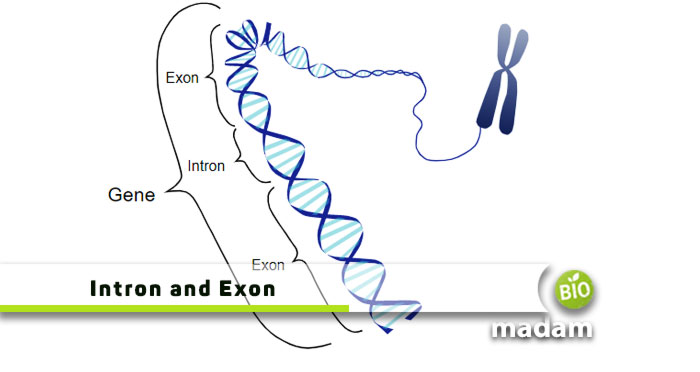Introns and exons are nucleotide sequences within genes. Introns allow alternative splicing to produce multiple proteins indirectly from a single gene. On the other hand, exons refer to segments of DNA and RNA that only contain information for a particular protein. Eventually, they both contribute to the formation of different types of proteins in the body for growth and development. Let’s tell you about the differences between introns and exons in detail.
Comparison Table
| Characteristics | Intron | Exon |
| Found In | Eukaryotes | Prokaryotes and eukaryotes |
| Location | Nucleus | Nucleus and cytoplasm |
| Coding Properties | Non-coding components | Coding components |
| Sequence Conversion | Altering | Conserved |
What are Introns?
Introns are sections of the gene that do not directly code for proteins and are present only in the precursor mRNA. Through the process of RNA splicing, introns get eliminated. Introns are found only in eukaryotes, while prokaryotes lack introns.
Introns constitute 90% of a gene and can have 10,000 long nucleotide sequences longer than exons. Introns exist alternative to the exon in DNA with specific triplet codes.

History of Introns
Introns are most commonly present in the genes of higher eukaryotic cell organisms like mammals and birds. They are less common in lower eukaryotes like yeast and rare in prokaryotes, like bacteria. The analysis of highly conserved genes in evolution proposes that introns were present in most organisms decades back. Hence, evolution in prokaryotes causes them to lose in primitive organisms. However, introns are recent gene development in higher animals.
Functions
Introns do not code for proteins, whereas they play an essential part in other functions of intracellular RNA. Although introns are non-coding segments, they play a role in gene regulation. They perform a vital function in gene evolution, as their removal during splicing gives rise to unique exon sequences. If we delete some of the introns from a gene, the DNA will get shorter, and the sequence will shuffle, resulting in a mutation.
What are Exons?
Exons are segments of gene sequences or nucleotides in eukaryotic or prokaryotic DNA and RNA.
Exons are the encoded sequences for the specific amino acids of the protein. They are present in mature mRNA after post-transcriptional modification in pre-mRNA. The exon sequences are highly conserved, i.e., they do not change with time. Exomes are an entire set of exons present in the genome. Exons constitute approximately 1.1% of the whole genome in humans. Exons constitute a tiny part of the entire genome.

History of Exons
Walter Gilbert first discovered exons in 1978. He coined the term exons for the regions on the DNA and RNA which will express protein synthesis. This definition was also later used for RNA molecules exhibiting from different parts of the genome and later joined through trans-splicing.
Function
Alternative Splicing-It is a technique by which various combinations of exons assemble to constitute a single gene code. Walter Gilbert first presented the idea that unique permutations of exons can make distinct protein isoforms. The protein structures have particular chemical and biological functions.
Difference between Introns and Exons
Definition
Introns
Introns are RNA or DNA molecules which do not directly code for proteins in the body.
Exons
Exons are defined as segments of RNA and DNA molecules containing information for a particular protein structure only.
Found In
Introns
Introns are present in eukaryotes.
Exons
While, exons are present in both prokaryotes and eukaryotes.
Location
Introns
Introns exist in the nucleus and get removed from the primary mRNA.
Exons
At the same time, exons are present in the nucleus (precursor RNA), and they leave the nucleus to the cytoplasm when they mature.
Function
Introns
The role of an intron is unspecified, though it is a substantial fraction of DNA.
Exons
However, exons take part in translation because of the codon’s instruction.
Coding Properties
Introns
Introns are non-coding components of DNA.
Exons
Contrarily, exons are the coding components of DNA that encode an amino acid sequence to make proteins.
Sequence Conservation
Introns
Introns are not conserved, i.e., they alter with time.
Exons
Whereas, exons are highly conserved, i.e., the codes are maintained and do not change their arrangement.
Arrangement of Intron and Exon in a Gene
In prokaryotes, new mRNA contains a continuous sequence of codons. So, the entire mRNA contains one particular codon called an exon, which expresses itself in proteins. Scientists suggested that all eukaryotic cells also have non-coding regions known as introns. So, in eukaryotes, two alternative segments are present in pre-mRNA.
Introns and Exons Role During Transcription
Prokaryotes do not need to alter RNA because they make mature RNA that is fully functional. Consequently, recently produced mRNA comprises only exon sequences that; they utilize to synthesize proteins. Because of this, the prokaryotic cell can initiate translating the mRNA before transcription is over.
In eukaryotes, premature mRNA goes-through post-transcription transformation before it results in mature RNA and formulates proteins. So, the pre-mRNA includes non-coding segments called introns and coding regions named exons. Spliceosomes are the complex of RNA and proteins, which remove introns to bring exons together. Moreover, at both ends of the mRNA, a base alteration occurs.
The Bottom Line
Introns and exons play a major role in the production of proteins in the body. They are present in prokaryotes and eukaryotes, varying in their number. Introns are higher in number in eukaryotic organisms compared to prokaryotes. Eukaryotic mRNA has altering intron and exon segments. Moreover, the intron sequences alter with time, whereas the exon sequences are highly conserved. At the same time, exons are a major part of translation, while introns do not directly contribute to protein synthesis.
FAQs
When are introns removed?
Introns are removed during splicing to facilitate the production of proteins. The pre-mRNA may contain more exons than introns.
What is the role of introns and exons in protein synthesis?
Exons bond covalently with each other to generate mature mRNA molecules. Alternatively, introns are removed during RNA splicing and are not expressed in the final product.
What separates introns and exons?
Introns do not directly play a role in protein synthesis, while exons are present in the RNA segment that translates into proteins. Introns are intervening sections of the DNA that separate exons.

Jeannie has achieved her Master’s degree in science and technology and is further pursuing a Ph.D. She desires to provide you the validated knowledge about science, technology, and the environment through writing articles.

